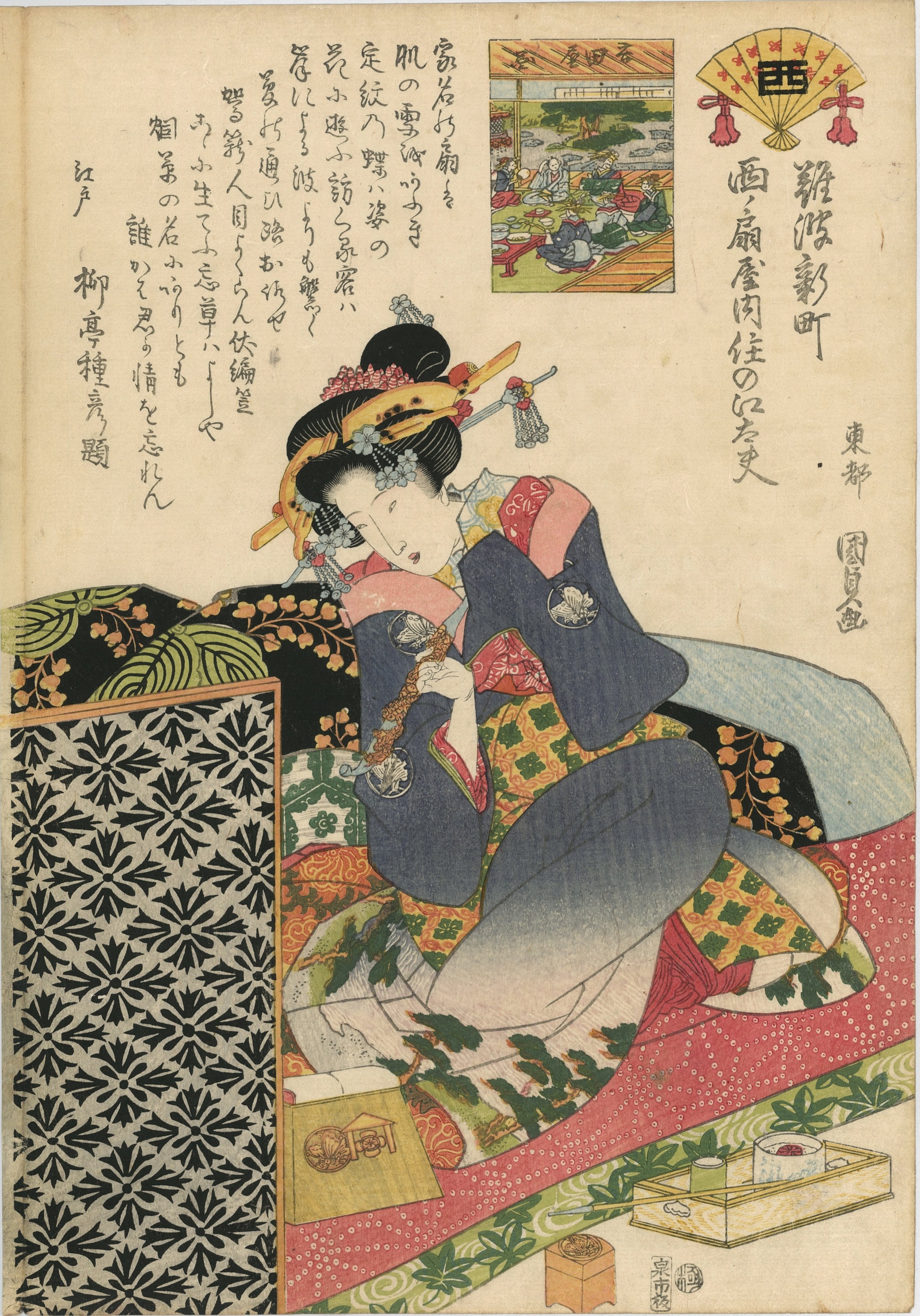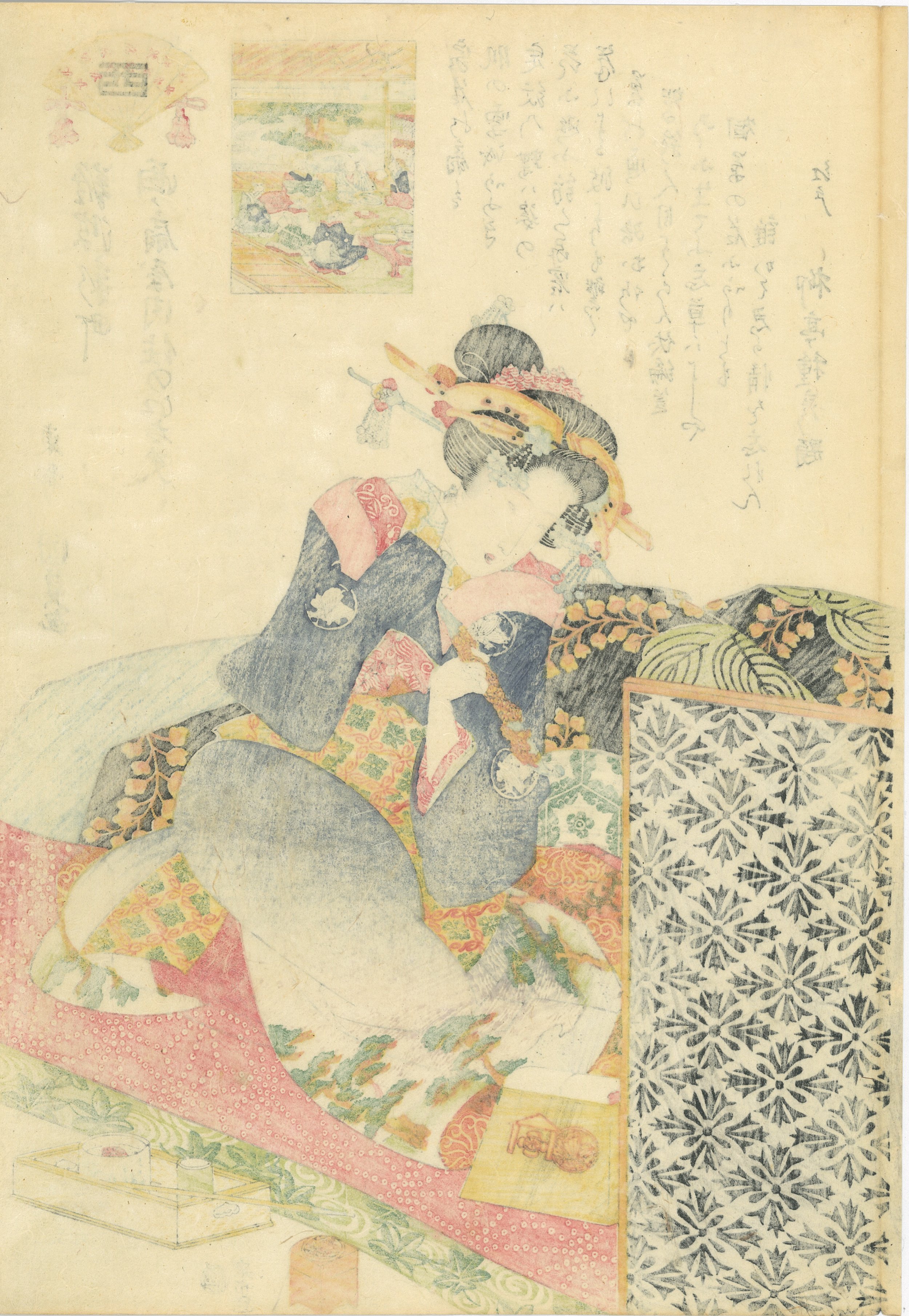Kunisada (Toyokuni III) | The High-Ranking Courtesan Suminoe of Ogiya, Naniwa-shinmachi, Osaka
歌川国貞(三代目歌川豐国) Utagawa Kunisada (Toyokuni III) (1786–1865)
難波新町 西ノ扇屋内住の江太夫
The High-Ranking Courtesan Suminoe of Ogiya, Naniwa-shinmachi, Osaka
1821
木版画 | 纵绘大判 | 37.5cm x 26.3cm
Woodblock-print | Oban tate-e | 37.5cm x 26.3cm
早期版次;颜色鲜艳;整体品相非常好,左边边缘处有一道册页夹痕
Early edition; strong color; one album clip mark on the very left side; otherwise good condition
$5,500
Who is the mystery man?
There is an implied eroticism in many Ukiyoe woodblock prints, and this wonderful and rare early Kunisada design with its intricate patterns and graceful bokashi is a prime example. Here was see the courtesan Suminoe lounging seductively on a lush futon in her flowing, layered kimonos, with a little bit of sexy red undergarment peeking out. But while the male viewer may direct his gaze at her, this print is filled with clues that someone else is hidden behind that screen.
Is it a lover? A patron? A customer? All we know is, the courtesan is holding a man’s pipe while her feminine pipe sits on the floor. Is she lighting it for her lover after an assignation? The cartouche above her head suggests a party. Was it earlier this evening, or is it occurring now while these two secret themselves away upstairs?
The Ukiyoe scholar and Manhattan gallery director Katherine Martin notes that this is a young tayu – or highest-ranking courtesan – and that the characters on the fan in the upper right hand corner alert us to the fact that this scene is unfolding in Osaka. She also notes that Kunisada, in his extraordinarily prolific career, executed several versions of this design, with this being the rarest.
We’ve seen such hints of secret carnal doings in plenty of wood block prints, such as this wonderful design by Eisen – again, the pipe tells us a man is lurking – and this famed example by Hiroshige that takes us into a brothel and depicts enough accruements lying around to suggest that an encounter of the physical kind has just transpired.
难波新町,即新町游廓,是江户时代大阪地区唯一受到幕府官方认可而设立的游廓,原地域约位于今大阪府大阪市西区新町。
在以描绘游廓为主题的许多浮世绘中,都暗含有或多或少的暧昧情趣。本作中,一身松原图羽蝶家纹衣装的江太夫看样子是刚从一场盛大的聚会或宴席中退场,尚头顶银簪玳瑁光。此时的她将身姿随意地弯作诱人曲线,慵懒地倚坐在锦地蒲团上,右手正捏着一杆明显为男士使用的银地高雕金盘龙烟管,而她自己所惯用的细长女式烟管,则半架于身旁地上的烟草盆中。也许,在那扇屏风后,正站立着一位大名家的男子——情人耶?客人耶?或许永远不得而知。
值得一提的是,极为高产的三代丰国在他的职业生涯中为此作创作了设色不同的多个版本,而本作是其中最稀少的一版,存世罕有,值得雅蓄。
Interested in purchasing?
Please contact us.
歌川国貞(三代目歌川豐国) Utagawa Kunisada (Toyokuni III) (1786–1865)
難波新町 西ノ扇屋内住の江太夫
The High-Ranking Courtesan Suminoe of Ogiya, Naniwa-shinmachi, Osaka
1821
木版画 | 纵绘大判 | 37.5cm x 26.3cm
Woodblock-print | Oban tate-e | 37.5cm x 26.3cm
早期版次;颜色鲜艳;整体品相非常好,左边边缘处有一道册页夹痕
Early edition; strong color; one album clip mark on the very left side; otherwise good condition
$5,500
Who is the mystery man?
There is an implied eroticism in many Ukiyoe woodblock prints, and this wonderful and rare early Kunisada design with its intricate patterns and graceful bokashi is a prime example. Here was see the courtesan Suminoe lounging seductively on a lush futon in her flowing, layered kimonos, with a little bit of sexy red undergarment peeking out. But while the male viewer may direct his gaze at her, this print is filled with clues that someone else is hidden behind that screen.
Is it a lover? A patron? A customer? All we know is, the courtesan is holding a man’s pipe while her feminine pipe sits on the floor. Is she lighting it for her lover after an assignation? The cartouche above her head suggests a party. Was it earlier this evening, or is it occurring now while these two secret themselves away upstairs?
The Ukiyoe scholar and Manhattan gallery director Katherine Martin notes that this is a young tayu – or highest-ranking courtesan – and that the characters on the fan in the upper right hand corner alert us to the fact that this scene is unfolding in Osaka. She also notes that Kunisada, in his extraordinarily prolific career, executed several versions of this design, with this being the rarest.
We’ve seen such hints of secret carnal doings in plenty of wood block prints, such as this wonderful design by Eisen – again, the pipe tells us a man is lurking – and this famed example by Hiroshige that takes us into a brothel and depicts enough accruements lying around to suggest that an encounter of the physical kind has just transpired.
难波新町,即新町游廓,是江户时代大阪地区唯一受到幕府官方认可而设立的游廓,原地域约位于今大阪府大阪市西区新町。
在以描绘游廓为主题的许多浮世绘中,都暗含有或多或少的暧昧情趣。本作中,一身松原图羽蝶家纹衣装的江太夫看样子是刚从一场盛大的聚会或宴席中退场,尚头顶银簪玳瑁光。此时的她将身姿随意地弯作诱人曲线,慵懒地倚坐在锦地蒲团上,右手正捏着一杆明显为男士使用的银地高雕金盘龙烟管,而她自己所惯用的细长女式烟管,则半架于身旁地上的烟草盆中。也许,在那扇屏风后,正站立着一位大名家的男子——情人耶?客人耶?或许永远不得而知。
值得一提的是,极为高产的三代丰国在他的职业生涯中为此作创作了设色不同的多个版本,而本作是其中最稀少的一版,存世罕有,值得雅蓄。
Interested in purchasing?
Please contact us.
歌川国貞(三代目歌川豐国) Utagawa Kunisada (Toyokuni III) (1786–1865)
難波新町 西ノ扇屋内住の江太夫
The High-Ranking Courtesan Suminoe of Ogiya, Naniwa-shinmachi, Osaka
1821
木版画 | 纵绘大判 | 37.5cm x 26.3cm
Woodblock-print | Oban tate-e | 37.5cm x 26.3cm
早期版次;颜色鲜艳;整体品相非常好,左边边缘处有一道册页夹痕
Early edition; strong color; one album clip mark on the very left side; otherwise good condition
$5,500
Who is the mystery man?
There is an implied eroticism in many Ukiyoe woodblock prints, and this wonderful and rare early Kunisada design with its intricate patterns and graceful bokashi is a prime example. Here was see the courtesan Suminoe lounging seductively on a lush futon in her flowing, layered kimonos, with a little bit of sexy red undergarment peeking out. But while the male viewer may direct his gaze at her, this print is filled with clues that someone else is hidden behind that screen.
Is it a lover? A patron? A customer? All we know is, the courtesan is holding a man’s pipe while her feminine pipe sits on the floor. Is she lighting it for her lover after an assignation? The cartouche above her head suggests a party. Was it earlier this evening, or is it occurring now while these two secret themselves away upstairs?
The Ukiyoe scholar and Manhattan gallery director Katherine Martin notes that this is a young tayu – or highest-ranking courtesan – and that the characters on the fan in the upper right hand corner alert us to the fact that this scene is unfolding in Osaka. She also notes that Kunisada, in his extraordinarily prolific career, executed several versions of this design, with this being the rarest.
We’ve seen such hints of secret carnal doings in plenty of wood block prints, such as this wonderful design by Eisen – again, the pipe tells us a man is lurking – and this famed example by Hiroshige that takes us into a brothel and depicts enough accruements lying around to suggest that an encounter of the physical kind has just transpired.
难波新町,即新町游廓,是江户时代大阪地区唯一受到幕府官方认可而设立的游廓,原地域约位于今大阪府大阪市西区新町。
在以描绘游廓为主题的许多浮世绘中,都暗含有或多或少的暧昧情趣。本作中,一身松原图羽蝶家纹衣装的江太夫看样子是刚从一场盛大的聚会或宴席中退场,尚头顶银簪玳瑁光。此时的她将身姿随意地弯作诱人曲线,慵懒地倚坐在锦地蒲团上,右手正捏着一杆明显为男士使用的银地高雕金盘龙烟管,而她自己所惯用的细长女式烟管,则半架于身旁地上的烟草盆中。也许,在那扇屏风后,正站立着一位大名家的男子——情人耶?客人耶?或许永远不得而知。
值得一提的是,极为高产的三代丰国在他的职业生涯中为此作创作了设色不同的多个版本,而本作是其中最稀少的一版,存世罕有,值得雅蓄。
Interested in purchasing?
Please contact us.
Utagawa Toyokuni III (1786–1865)
In the pantheon of Japanese woodblock prints, some names loom large and legendary – Hokusai, Hiroshige, Utamaro, to name a few. Each in his own way revolutionized his genre. But for sheer productivity and quality and longevity, no one rivals the great Utagawa Kunisada. He was without a doubt the most prolific Ukiyo-e artist of the Edo period, and the quality of his work was remarkably high throughout his lifetime.
His life caught the tail end of the early golden age of Ukiyo-e and ended during the final, halcyon days of Japanese woodblock printmaking. His legacy lived on with many famous pupils. In between, he produced countless designs of bijin (beautiful women), warriors, legends, Surimono, more bijin, the Tale of Genji, actors, landscapes, Shunga, fan prints and even more bijin. He led the Utagawa School, home to Hiroshige among others, for nearly 40 years.
His work embraced a subtle elegance and simplicity, a timelessness, when other woodblock artists often favored busy energy. Except when it didn’t. (Read on.)
He was born in 1796 and always had a steady income from his family’s ferry business – making him unusual in the world of Ukiyo-e, where so many struggled to make ends meet. He became a student of Toyokuni when he was 15. The master gave him the name Kunisada, using the tradition of a teacher starting a student’s name with the end of his own.
After getting his start doing book designs, Kunisada saw his first major successes in the 1820s. His initial specialties were bijin and warriors, as well as erotic books. He often put his subjects in well-drawn landscapes but rarely produced pure landscapes themselves.
One example of this occurred in the early 1830s when, reacting to the runaway success of Hiroshige’s Great Tokaido series, he began his own series that copied Hiroshige’s designs but placed a beautiful woman in the foreground. While Hiroshige’s prints were oban yoko-e (horizontal oban prints), Kunisada’s “copies” were smaller chuban-size prints, meaning two could be cut from a single oban-sized sheet. These little prints were phenomenally successful – as successful at least as Hiroshige’s – and eventually Kunisada was publishing his little Tokaido prints ahead of Hiroshige’s, and thus designing his own background landscapes.
Kunisada would later produce the “two-brush” Tokaido series with Hiroshige in the 1850s, in which he drew figures in the foreground while Hiroshige supplied beautiful little landscapes behind them. This was one of several notable woodblock print collaborations during his lifetime.
By then, Kunisada had taken the name Toyokuni III, to honor his master. (Toyokuni II had already been taken by Toyoshige, though Kunisada didn’t acknowledge the legitimacy. But that’s another story for another day.)
He kept going and going. In fact, in his long life, 1852 was his most productive year. His design skills were later matched by new technologies in woodblock prints, and some of his final series feature spectacular and intricate production, such as “Lasting Impressions of a Later Genji Collection” in 1859-61 and “A Contest of Magic Scenes by Toyokuni” in 1861-4. Okay – this series was not subtle: It featured over-the-top designs of Kabuki actors with fabled and ghostly beasts. Double-printing, mica, burnishing, raised printing, heavy paper, complex bokashi – no expense was spared for these deluxe editions.
Kunisada was generous with his students, many of whom went on to great success, including Kunichika, Kunisada II, Sadahide, and Kunihisa II. This last pupil, who among other projects designed the in-set landscapes in Kunisada’s wonderful “100 Famous Sights in Edo Matched with Beautiful Women” in 1857-1858, was a rarity among Ukiyo-e artists – a woman.
Kunisada died in 1865, just three years before the end of the Tokugawa epoch, leaving behind a body of work unmatched in his time.
Don’t believe me? Checkout The Kunisada Project. It’s all there. Just make sure you have some time.
Citation: Research for this brief biography included “Japanese Woodblock Prints” by Andreas Marks (Tuttle; 2010), among other sources.


